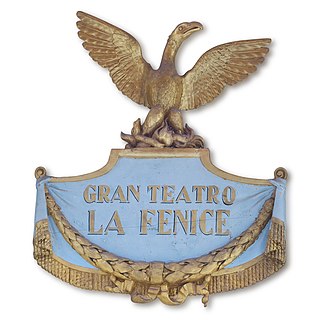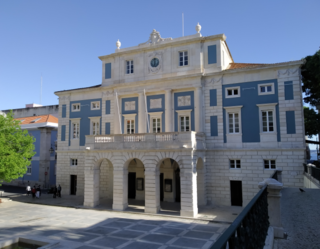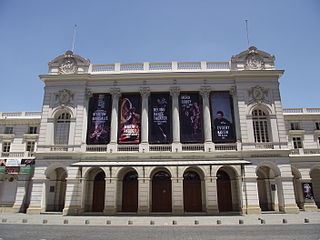
The Teatro Colón is a historic opera house in Buenos Aires, Argentina. It is considered one of the ten best opera houses in the world by National Geographic. According to a survey carried out by the acoustics expert Leo Beranek among leading international opera and orchestra directors, the Teatro Colón has the room with the best acoustics for opera and the second best for concerts in the world.

Teatro La Fenice is a historic opera house in Venice, Italy. It is one of "the most famous and renowned landmarks in the history of Italian theatre" and in the history of opera as a whole. Especially in the 19th century, La Fenice became the site of many famous operatic premieres at which the works of several of the four major bel canto era composers—Rossini, Bellini, Donizetti, and Verdi—were performed.

The Teatro Nacional de São Carlos is an opera house in Lisbon, Portugal. It was opened on June 30, 1793 by Queen Maria I as a replacement for the Tejo Opera House, which was destroyed in the 1755 Lisbon earthquake. The theatre is located in the historical center of Lisbon, in the Chiado district.

The Real Teatro di San Carlo, as originally named by the Bourbon monarchy but today known simply as the Teatro (di) San Carlo, is a historic opera house in Naples, Italy, connected to the Royal Palace and adjacent to the Piazza del Plebiscito. It is the oldest continuously active venue for opera in the world, having opened in 1737, decades before either Milan's La Scala or Venice's La Fenice.

The Teatro Regio is a prominent opera house and opera company in Turin, Piedmont, Italy. Its season runs from October to June with the presentation of eight or nine operas given from five to twelve performances of each.

The Teatro Massimo Vittorio Emanuele is an opera house and opera company located on the Piazza Verdi in Palermo, Sicily. It was dedicated to King Victor Emanuel II. It is the biggest in Italy, and one of the largest of Europe, renowned for its perfect acoustics.

The Teatro dell'Opera di Roma is an opera house in Rome, Italy. Originally opened in November 1880 as the 2,212 seat Costanzi Theatre, it has undergone several changes of name as well modifications and improvements. The present house seats 1,560.

The Teatro della Pergola, sometimes known as just La Pergola, is a historic opera house in Florence, Italy. It is located in the centre of the city on the Via della Pergola, from which the theatre takes its name. It was built in 1656 under the patronage of Cardinal Giancarlo de' Medici to designs by the architect Ferdinando Tacca, son of the sculptor Pietro Tacca; its inaugural production was the opera buffa, Il potestà di Colognole by Jacopo Melani. The opera house, the first to be built with superposed tiers of boxes rather than raked semi-circular seating in the Roman fashion, is considered to be the oldest in Italy, having occupied the same site for more than 350 years.

The Teatro Argentina is an opera house and theatre located in Largo di Torre Argentina, a square in Rome, Italy. One of the oldest theatres in Rome, it was constructed in 1731 and inaugurated on 31 January 1732 with Berenice by Domenico Sarro. It is built over part of the curia section of the Theatre of Pompey. This curia was the location of the assassination of Julius Caesar.

The Teatro Massimo Bellini is an opera house located on Piazza Vincenzo Bellini in Catania, Sicily, southern Italy. Named after the local-born composer Vincenzo Bellini, it was inaugurated on 31 May 1890 with a performance of the composer's masterwork, Norma. It seats 1,200.
Beyond Florence, there are nine other provinces in the region of Tuscany, named for the largest city in, and capital of, the respective province. Taken together, they offer an intense musical life.
Theatres for diverse musical and dramatic presentations began to open in Naples, Italy, in the mid-16th century as part of the general Spanish cultural and political expansion into the kingdom of Naples, which had just become a vicerealm of Spain. None of the early theaters still function as such, having been replaced by later facilities from the mid-18th century onwards. Neapolitan theatres first built in the 16th and 17th centuries include:

The Teatro Comunale in Ferrara is an opera house, located in the Italian region of Emilia-Romagna, and built between 1786 and 1797 with seating for 990. Privately owned theatres with limited seating capacity had existed in the city for many years, but the arrival of Cardinal Spinelli, the new papal envoy, in 1786 spurred the construction of a new public theatre under the architects Cosimo Morelli and Antonio Foschini. However, their disagreements led to conflicting design concepts regarding the elliptical shape of the auditorium which were resolved through compromise. The theatre was finally ready for its inaugural presentation of Portogallo's Gli Orazi e i Curiazi on 2 September 1798.

The Teatro Valle is a theatre and former opera house in Rome, Italy. It was built in 1726 for the Capranica family. In the middle of the 19th century, it switched from staging opera and theatre to only performances of spoken drama. After closing down in 2010, it was squatted in 2011, then in 2014, the squatters were evicted.

The Teatro Municipal, National Opera of Chile is the most important stage theatre and opera house in Santiago, Chile.

The Teatro San Benedetto was a theatre in Venice, particularly prominent in the operatic life of the city in the 18th and early 19th centuries. It saw the premieres of over 140 operas, including Rossini's L'italiana in Algeri, and was the theatre of choice for the presentation of opera seria until La Fenice was built in 1792.

The Teatro Donizetti is an opera house in Bergamo, Italy. Built in the 1780s using a design by architect Giovanni Francesco Lucchini, the theatre was originally referred to as either the Teatro Nuovo or Teatro di Fiera. The first opera to be mounted at the theatre, Giuseppe Sarti's Medonte, re di Epiro, was in 1784 while the opera house was still under construction. The official opening of the house, under the name the Teatro Riccardi, did not occur until 24 August 1791 with a production of Pietro Metastasio's Didone abbandonata set to music by multiple composers, including Ferdinando Bertoni, Giacomo Rampini, Johann Gottlieb Naumann, Giuseppe Gazzaniga, and Giovanni Paisiello.

The Teatro Carcano is a theatre in Milan, Italy, located at 63 Corso di Porta Romana. Although now exclusively devoted to plays and dance, it served as an opera house for much of the 19th century and saw the premieres of several important operas. Completed in 1803, the theatre was commissioned by the Milanese aristocrat and theatre-lover Giuseppe Carcano and originally designed by Luigi Canonica. Over the succeeding two centuries it has undergone several restructurings and renovations and for a time in the mid-20th century functioned as a cinema.

The Teatro della Fortuna is a music and theater venue in Fano, province of Pesaro and Urbino, region of Marche, Italy.

The Teatro Fraschini is an opera house in Pavia, Italy.



















